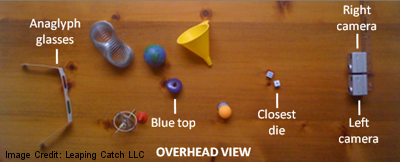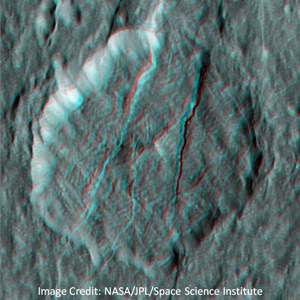 |
 |
| Home | Experience | Services | Name | Interest | Contact |
Film and HSD Imaging | Visible and Infrared Imaging | Stereoscopic 3D Imaging |
 |
|
Stereoscopic 3D Imaging Our two eyes independently and simultaneously view a common scene from slightly different locations. The figure below is an overhead view of several objects on a coffee table. The distance between the two small cameras at the far right approximates the typical eye separation of an adult human.  Each camera took a picture of the stationary scene. These pictures are shown below.  The objects appear to have shifted between the two views, a phenomenon known as parallax. Also notice that the die closest to the cameras appears to shift more relative to the red/cyan (anaglyph) glasses in the background than does the blue top. The closest die shifts nearly the width of the glasses, whereas the blue top shifts less than half that amount. Parallax is providing cues for depth perception. The closer the object, the greater its parallax or shift relative to a background reference. Parallax is an important cue, though not the only cue, that the brain processes to provide depth perception. Depth perception is essential for navigating through our three-dimensional world.
"How far away is that car? Do I have time to cross the street before it gets here?" A Shuttle launch is observed by many cameras from many vantage points. Analysts pore over this imagery to look for different camera views that recorded the debris. If multiple cameras recorded the debris, analysts can reconstruct its three dimensional trajectory from the various camera views. However, this is a time-consuming process. Indeed, identifying a common piece of debris in multiple camera views is, in itself, time-consuming. The analysis process could be streamlined if imagery provided parallax depth perception cues. Stereoscopic 3D imagery does just that. Stereoscopic 3D imagery is imagery of a common scene acquired from two different vantage points and displayed in a fashion that enables the perception of depth from parallax cues. If the imagery analysts in the above scenario were provided stereoscopic 3D imagery, it might be possible from visual inspection alone to determine whether the debris was on a collision course with the vehicle. If the stereo-3D view showed the debris moving harmlessly away from the vehicle, there would be no need to waste precious time and resources analyzing its trajectory. Instead, resources could be applied to higher priority tasks.  Two camera views, one from the left and one from the right, are required to generate stereoscopic 3D imagery. When the scene is relatively static, a single camera can be moved to acquire the left and right views. For example, the stereoscopic view of the crater at right was generated from two images acquired by a single camera on the Cassini spacecraft that moved between images. When imaging a dynamic scene, such as a launch, in which there is significant frame-to-frame motion, the two views need to be acquired simultaneously. Two camera views, one from the left and one from the right, are required to generate stereoscopic 3D imagery. When the scene is relatively static, a single camera can be moved to acquire the left and right views. For example, the stereoscopic view of the crater at right was generated from two images acquired by a single camera on the Cassini spacecraft that moved between images. When imaging a dynamic scene, such as a launch, in which there is significant frame-to-frame motion, the two views need to be acquired simultaneously.In order for the brain to perceive depth from parallax cues, the view of the scene from the left vantage point must be presented only to the left eye and the view of the scene from the right vantage point must be presented only to the right eye. Hence, special display systems and/or eyewear are required to ensure that each eye is presented only its appropriate view. There are many different methods of achieving this. As one example, the crater image is presented here in anaglyph form with the left camera's view tinted red and the right camera's view tinted cyan. Special anaglyph glasses like those shown above, having a red filter for the left eye and a cyan filter for the right eye, are required to perceive depth in this stereo-3D image. There are numerous technologies involved in planning for, acquiring, transmitting, recording, processing, displaying, viewing, and analyzing stereoscopic 3D imagery. These technologies are rapidly evolving. |
A woman-owned small business. |
 |
|
|